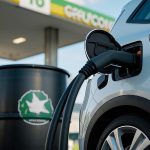The Silent Revolution: BYD’s Overtaking of Tesla
When BYD’s Q4 2023 sales figures revealed 526,000 all-electric vehicles sold – surpassing Tesla’s 484,000 – it marked more than a corporate milestone. This symbolic shift exposed the new reality: Chinese EV makers now control 60% of global production capacity, leveraging vertical integration from lithium mines to software ecosystems.
I. Blade Battery Breakthrough: The Technology Arms Race
BYD’s game-changing Blade Battery technology demonstrates China’s strategic advantage:
- 30% higher energy density than conventional LFP batteries
- Survives nail penetration tests without combustion (a Tesla Model 3 fails)
- 40% cheaper production costs through patented cell-to-pack design
This innovation enabled BYD’s Seagull EV to retail at $11,000 – cheaper than most ICE subcompacts. Meanwhile, CATL’s new condensed battery promises 500Wh/kg density (double current standards), threatening to make legacy automakers’ R&D obsolete.
II. The European Onslaught: Tariffs vs Technology
The EU’s 38% anti-subsidy tariffs on Chinese EVs backfired spectacularly:
- BYD announced Hungarian factory plans within 72 hours of tariff announcement
- SAIC’s MG Cyberster sports EV sold out 2024 allocations in UK/DE in 3 days
- Chinese EV registrations in EU still grew 25% YoY post-tariffs
European automakers face an existential dilemma – Volkswagen’s 700millionXPengpartnershipandStellantis′1.6 billion Leapmotor investment reveal desperation to access Chinese EV tech.
III. The New Silk Road: EV Diplomacy
China’s Belt and Road Initiative evolved into “Battery Road”:
- 83 lithium mining projects across Africa/South America
- $14 billion Indonesia nickel processing complex
- Thailand’s new EV tax incentives benefiting Chinese manufacturers
This resource control lets Chinese firms avoid Western sanctions while building alternative supply chains. Morocco emerges as key battleground – BYD/CATL factories near Tangier-Med port position to supply Europe/Africa duty-free.
Conclusion
The EV revolution has become China’s economic Trojan Horse. As NIO’s battery swap stations outnumber gas stations in Norway’s major cities, the West faces a painful choice: protectionism or technological surrender. With Chinese EVs projected to capture 33% global market share by 2025, the automotive world order has irrevocably changed.

















